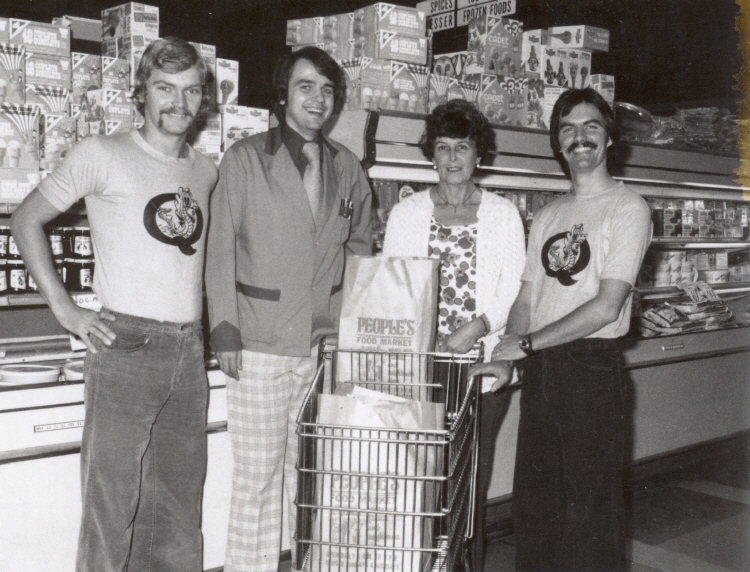
Jim Hughson

Jim pictured at left at CKIQ at a store promotion
Jim
Hughson - DJ/news/sports/sales CKNL Fort St. John BC; CKIQ Kelowna;
CKNW Vancouver sports 1979-1982; Toronto Maple Leafs play-by-play CBC TV
1982-86; TSN hockey & baseball 1986-1994; Vancouver Canucks play-by-play
CKNW Vancouver 1994-1999; Snapshots Host/Canucks Hockey play-by-play/Centre Ice
feature analyst Sportsnet 1999-current; western
Canucks games play-by-play CBC 2005-current.
***
1983
Hockey
play-by-play announcers should keep their mouths shut more often, the former
voice of Hockey Night in
Bill
Hewitt, who retired recently after 30 years of play-by-play broadcasting,
believes that announcers in this country today are a collection of motor-mouths
who don't concentrate enough on describing the game and spend too much time
digressing from it. He says he has heard similar complaints from fans who say
the announcers he criticizes are irritating them as well.
One
announcer whom Hewitt believes is guilty of discussing peripheral subjects too
often during the action is Jim Hughson, who succeeded Hewitt this season as the
Toronto Maple Leaf announcer on weeknight telecasts. "I think the young
fellow does much too much talking about other things while the play is on,"
Hewitt says. "He comes up with trivia that really doesn't have any bearing
on what is going on on the ice. I don't like it at
all. Hockey's too fast for intermediary commentary. It's okay for football when
you have so much time between play, but I just don't like it in hockey. "He
(Hughson) has tremendous potential, but he has to stop talking so much. He has
to leave the color commentary to the color commentator. And it's not just him.
They're all doing it now. It bothers me. It has to go back to the old format,
where announcers simply described what was taking place on the ice."
Hewitt, of course, followed the old format strictly, as did Danny Gallivan,
then his
The
younger Hewitt agrees with his father that contemporary broadcasters "try
to joke too much and be comedians" on the air. He also feels that there are
too many teams in the National Hockey League - which has resulted in a diluted
product - and too many raw, junior-age players who aren't ready for professional
hockey.
***
1985
Since
just before television discovered sports, a persistent
belief in and out of broadcasting has been that radio-style play-by-play
announcing cannot, or should not, be transferred to TV. Viewers can see what is
happening, the argument goes, so why insult them by describing a game as though
they cannot?
By and
large this opinion is held by broadcasting people who do not do play-by-play,
and ignored by those who do. That leaves a fine theory but one that's difficult
to assess, except the once it was carried to the extreme and was a disaster.
That was the NBC experiment of telecasting a football game without running
commentary. It was as exciting as silent movies and went the same way.
There
is evidence, though, that a merger of the two styles will work. For the past
three seasons Jim Hughson has been doing play-by-play of the Toronto Maple Leafs
games on Channel 11. Mostly his approach is radio- style, but sometimes he
throws in asides not directly related to what's on the screen and sometimes he
will say nothing. For a second, maybe two, there will be silence.
It adds
up to relaxed, easy listening. "I'm consciously doing it more and
more," Hughson said recently. "A few seconds (of silence) here and
there, I think, is a chance for the audience to take a breath, too.
"When I first came down here I was strictly radio-style. I still
think there is a degree to which that is necessary. You have to pick your spots
because there are times in (
***
1991
Between
the hockey, and his summer work with Ken Singleton on Montreal Expos broadcasts,
the
Who's
better? Not Don Wittman. Chris Cuthbert? Maybe, if
he had a major sport to work after hockey, as Hughson does. Don
Chevrier? Could be, but
Chevy's working more American games than Canadian these days.
Hughson
came up the same way everyone else did -- on the back roads. There was Tier II
junior hockey in Kelowna at CKIQ radio; Brandon, and
the Tier I Wheat Kings; and eventually Vancouver, where he subbed for Jim
Robson, describing the Canucks 1982 Stanley Cup run on CKNW radio.
He has
also worked for Hockey Night in
"I've
got a closet full of jackets, but you can't wear any of them. Everyone had such
bad taste," he said.
***
1994
Hughson
was just a pup when he left CKNW in 1982 after a three-year stint on the
afternoon-evening shift and as Robson's backup before the era of simulcasts.
Single, with shaggy blond hair and a Fu Manchu mustache, he struck out for
Toronto and soon landed a job as the Leafs' mid-week TV play-by-play man. A
shave and a haircut ensued as did a bright career.
In
1986, Hughson moved to TSN to work their NHL and major-league baseball package.
He has enjoyed an eight-year association with the all-sports network that ends
with his final Blue Jay assignment (strike permitting) Sept. 29.
``People
in the east might not understand why I'd move, they might perceive it as a step
backwards,'' said Hughson, married with a four-year-old son. ``